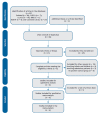Efficiency of different protocols for oral hygiene combined with the use of chlorhexidine in the prevention of ventilator-associated pneumonia
- PMID: 33503132
- PMCID: PMC7889317
- DOI: 10.36416/1806-3756/e20190286
Efficiency of different protocols for oral hygiene combined with the use of chlorhexidine in the prevention of ventilator-associated pneumonia
Abstract
Objective: In ICU patients on mechanical ventilation (MV), ventilator-associated pneumonia (VAP) is a common infection. However, such infection can be prevented through oral care protocols. The objective of this study was to compare the efficiency of the use of chlorhexidine and oral hygiene protocols (brushing and clinical procedures) with that of the use of chlorhexidine alone (intervention group and control group, respectively) in decreasing the prevalence of VAP in patients ≥ 18 years of age admitted to the ICU and requiring MV.
Methods: In this systematic review and meta-analysis, studies were identified through searches of various national and international databases, as well as of the gray literature, and were selected in accordance with eligibility criteria.
Results: We evaluated six studies, involving a collective total of 1,276 patients. We classified the risk of bias as low in three studies, high in two, and uncertain in one; among the six risk domains evaluated, a low risk of bias was predominant in five. The results for random risks were similar in terms of direction and statistical magnitude-chi-square = 6.34; risk difference: -0.06 (95% CI: -0.11 to -0.02); I2 = 21%; p = 0.007. There was a decrease in the prevalence of VAP in the intervention group (n = 1,276) included in the meta-analysis.
Conclusions: Protocols that include the mechanical removal of oral biofilm in combination with the use of chlorhexidine can reduce the incidence of VAP among ICU patients requiring MV.
Objetivo:: A pneumonia associada à ventilação mecânica (PAVM) é uma infecção frequente em UTI. No entanto, essa infecção pode ser evitada através de protocolos de cuidados orais. O objetivo deste estudo foi comparar a eficiência de protocolos de higiene bucal (escovação e procedimentos clínicos) aliados ao uso de clorexidina (grupo intervenção) com a de protocolos que fazem uso somente de clorexidina (grupo controle) na diminuição da prevalência da PAVM em pacientes adultos (≥ 18 anos) internados em UTI sob VM.
Métodos:: Nesta revisão sistemática e meta-análise, várias bases de dados nacionais e internacionais foram utilizadas para a identificação e seleção de estudos e literatura cinza seguindo critérios de elegibilidade.
Resultados:: Foram incluídos seis estudos, envolvendo 1.276 pacientes. Após a classificação dos estudos, três apresentaram baixo risco de viés, dois apresentaram risco de viés alto, e o risco foi incerto em um; entre os seis domínios avaliados houve predomínio de baixo risco de viés em cinco deles. Os resultados para riscos aleatórios foram semelhantes em direção e magnitude estatística - qui-quadrado = 6,34; diferença de risco: −0,06 (IC95%: −0,11 a −0,02); I2 = 21%; p = 0,007. Houve diminuição na prevalência de PAVM no grupo intervenção (n = 1.276) incluídos na meta-análise.
Conclusões:: Protocolos que incluem a remoção mecânica do biofilme associada ao uso de clorexidina podem reduzir a incidência de PAVM em pacientes internados em UTI sob VM.
Conflict of interest statement
Figures





References
Publication types
MeSH terms
Substances
LinkOut - more resources
Full Text Sources
Medical

